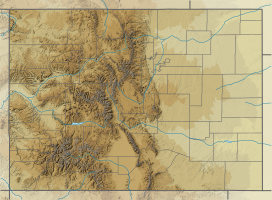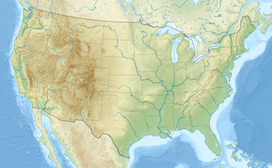
Blanca Peak is the fourth highest summit of the Rocky Mountains of North America and the U.S. state of Colorado. The ultra-prominent 14,351-foot (4,374 m) peak is the highest summit of the Sierra Blanca Massif, the Sangre de Cristo Range, and the Sangre de Cristo Mountains. The fourteener is located 9.6 miles (15.5 km) north by east of the Town of Blanca, on the drainage divide separating Rio Grande National Forest and Alamosa County from the Sangre de Cristo Land Grant and Costilla County. The summit is the highest point of both counties and the entire drainage basin of the Rio Grande. Below the steep North Face of Blanca Peak two live Glaciers once developed, until extinction sometime after 1903. North & South Blanca Glaciers were located at 37° 35N.,longitude 105° 28W. Blanca Peak is higher than any point in the United States east of its longitude.

Crestone Peak is the seventh-highest summit of the Rocky Mountains of North America and the U.S. state of Colorado. The prominent 14,296.8-foot (4,358 m) fourteener is the highest summit of the Crestones and the second-highest summit in the Sangre de Cristo Range after Blanca Peak. The summit is located in the Sangre de Cristo Wilderness of Rio Grande National Forest, 5.0 miles (8.1 km) east by south of the Town of Crestone in Saguache County, Colorado, United States.

Ellingwood Point is a high mountain summit in the Sangre de Cristo Range of the Rocky Mountains of North America. The 14,048-foot (4,282 m) fourteener is located on the Sierra Blanca Massif, 9.9 miles (16.0 km) north by east of the Town of Blanca, Colorado, United States, on the drainage divide separating the Rio Grande National Forest and Alamosa County from the San Isabel National Forest and Huerfano County. Ellingwood Point was named in honor of Albert Russell Ellingwood, an early pioneer of mountain climbing in the Western United States and in Colorado in particular.
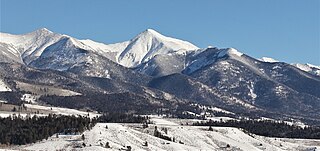
Hunts Peak is a 13,071-foot (3,984 m) mountain summit on the boundary shared by Fremont County and Saguache County, in Colorado, United States.

Mount Otto is a 12,865-foot (3,921 m) mountain summit on the boundary shared by Fremont County and Saguache County, in Colorado, United States.

Galena Peak is a 12,461-foot (3,798 m) mountain summit on the boundary shared by Fremont County and Saguache County, in Colorado, United States.

Horn Peak is a 13,450-foot (4,100 m) mountain summit in Custer County, Colorado, United States.

Spread Eagle Peak is a 13,423-foot (4,091 m) mountain summit in Custer County, Colorado, United States.
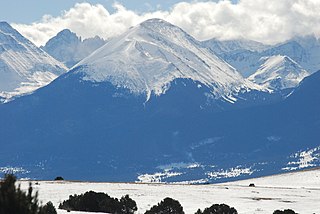
Colony Baldy is a 13,705-foot (4,177 m) mountain summit in Custer County, Colorado, United States.
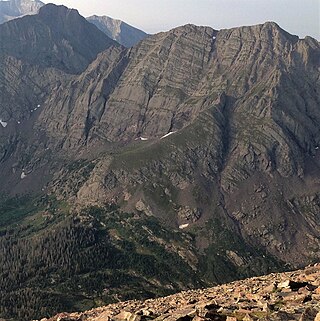
Broken Hand Peak is a 13,573-foot (4,137 m) mountain summit on the boundary shared by Custer and Saguache counties, in Colorado, United States.

Pico Aislado is a 13,611-foot (4,149 m) mountain summit in Saguache County, Colorado, United States.

Cleveland Peak is a 13,414-foot (4,089 m) mountain summit in Saguache County, Colorado, United States.
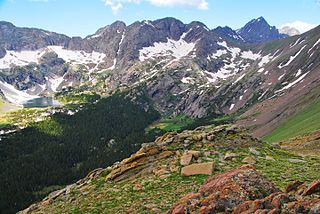
Milwaukee Peak is a 13,522-foot (4,122 m) mountain summit in Saguache County, Colorado, United States.

Eureka Mountain is a 13,507-foot (4,117 m) mountain summit on the boundary shared by Custer and Saguache counties, in Colorado, United States.

Electric Peak is a 13,598-foot (4,145 m) mountain summit on the boundary shared by Custer and Saguache counties, in Colorado, United States.
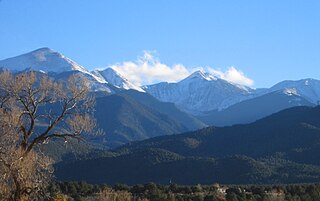
Cottonwood Peak is a 13,588-foot (4,142 m) mountain summit on the boundary shared by Custer and Saguache counties, in Colorado, United States.

Fluted Peak is a 13,554-foot (4,131 m) mountain summit on the boundary shared by Custer and Saguache counties, in Colorado, United States.

Gold Hill is a 12,716-foot elevation (3,876 m) mountain summit in Taos County, New Mexico, United States.

Lake Fork Peak is a 12,881-foot-elevation (3,926 m) mountain summit in Taos County, New Mexico, United States.

Pueblo Peak is a 12,303-foot-elevation (3,750-meter) summit in Taos County, New Mexico, United States.

